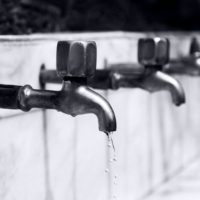Before It Gets Cold
1: Insulate.
Cover any exposed pipes in your home’s crawl space, attic and garage. If you have a well, be sure that the cover or pump house is sufficiently insulated.
2: Seal.
Close any openings that could allow cold air to move around water pipes.
3: Disconnect.
Remove all garden hoses from your outdoor hose bibs.
When the Temperature Drops
4: Trickle.
Moving water is more difficult to freeze. Let a small amount of warm water trickle overnight from the faucets.
5: Heat.
Set your thermostat to keep the house warmer on the coldest nights. You’ll pay a little more in heating costs, but that will likely be a lot cheaper than fixing broken pipes and damage from water.
6: Circulate.
Open cabinet doors below sinks—especially on outside walls—to let the heated air surround the exposed water pipes.
Got Trouble?
If you suspect that your water pipes have frozen, open the faucet and call Pumpro as soon as possible. Do not attempt to thaw pipes with a torch or open flame.
If a frozen water pipe bursts, shut off the water at the main supply valve, then call Pumpro as soon as possible.
